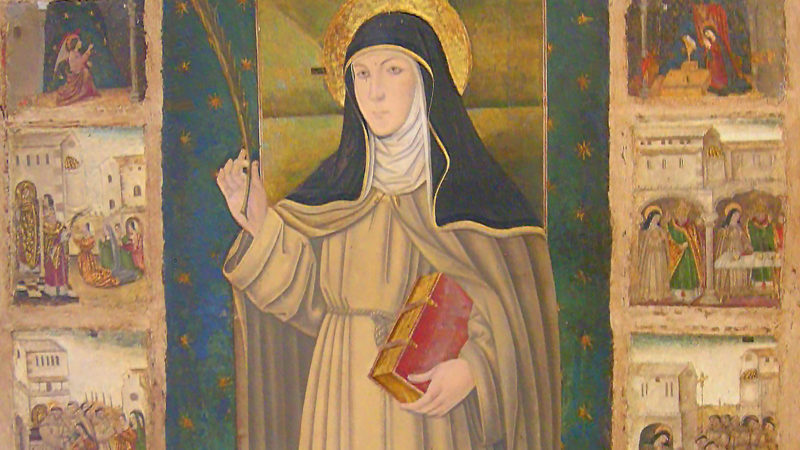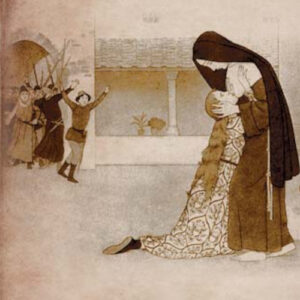
St. Agnes of Assisi was an abbess, and with her sister, a pioneer in establishing one of the great mendicant women’s religious orders. She was born Caterina Offreduccio c. 1197 to a noble family in Assisi, Italy. Her father was Count Favorino Scifi and her mother was [Bl.] Hortulana of the noble Fiumi family. The family had a castle on Mount Subiaso, as well as a mansion in the city of Assisi, and this is where Catarina spent her childhood. The mansion was adjacent to the San Rufino Cathedral, and the family worshipped there regularly. A young man from a prominent family, Francis Bernadone, had undergone a dramatic conversion several years earlier and was known to roam about preaching. On March 18, 1212, Catarina’s eighteen-year-old sister Chiara (Clare in English) slipped away from the family home to follow him. Clare was so moved by his witness that she resolved to follow his Christ-like example – permanently.
A NEW RELIGIOUS ORDER IS FOUNDED

Francis took Clare temporarily to a nearby Benedictine convent to protect her from her family members, infuriated at her bold departure. Sixteen days later, fifteen-year-old Catarina, determined to join her sister in following Francis, also clandestinely left the family home to join her sister at the convent. Receiving her, Francis gave her the new name, Agnes. Count Favorino was outraged at this double loss of his lovely and intelligent daughters, and he sent several armed relatives to the convent to bring the girls home, forcefully if necessary. Upon arrival, the girl’s Uncle Monaldo drew his sword, and his arm withered before their eyes. The other men dragged Agnes out of the monastery, and she fought them with all her strength. Two versions of what happened next are told. One is that they dragged her down the mountainside so violently that she was knocked unconscious. The other version is that her body became so miraculously heavy when Clare arrived to defend her, they simply could not carry her. Either way, they realized that they were battling against God and they left her there.

Francis was deeply moved by Agnes’s valiant resolve to join her sister in a life of voluntary poverty and he cut her long beautiful hair as he had done for her sister. The two young women were soon joined by a third woman, their aunt Pacifica. The three formed a unique bond and became the beginning of the Order of the Poor Ladies, later the second Franciscan Order known as the Poor Clares.
FAMILY REUNITED
The women were moved to San Damiano, where Francis himself built them a crude shelter adjacent to the church which he had helped to restore from decay. More women continued to join them in their radically counter-cultural lifestyle. The Franciscan friars and Poor Ladies strove to follow the ways of Jesus as closely as humanly possible. They travelled about from place to place, calling no place home. They ate very little, slept on the ground, and wore no shoes. Most avidly, they embraced “Lady Poverty”, having absolutely no possessions of their own. After the death of her husband, Clare and Agnes’s mother, Ortolana, sold the family fortune, gave it to the poor, and joined the Poor Ladies, and was invested personally by Francis. The youngest daughter of this remarkable family, Beatrice, was still young and thus was placed in the care of an uncle. She too joined the Poor Ladies when she became eighteen.
A WISE ABBESS
In 1219, Francis appointed Agnes as abbess of a new convent at Monticelli, near Florence. She was just twenty-two years old at the time. She governed the convent with charity and remarkable wisdom for one so young. She had the ability to teach her nuns to love and embrace the difficult road of virtuousness. Her heaviest cross was her painful separation from her mother and sisters. A touchingly beautiful letter written by Agnes for her sister Clare still exists. As abbess, she was steadfast in protecting Clare’s Rule of evangelical poverty, surely a most difficult way of living.
Because of her love for the charism of the Order, Agnes went on to establish new foundations in the northern part of Italy, including Padua, Venice, and Mantua. She governed her convent at Monticelli for more than thirty years. She returned to Assisi in 1253 when she learned that Clare was dying. She nursed her sister until she died on August 11, and she planned Clare’s beautiful funeral. Clare had prophesized that Agnes would die soon after her, and indeed Agnes died at Assisi on November 16 of that same year. She was interred next to her sisters and her mother. They remain there together at the Church of St. Clare in Assisi. Numerous miracles have been reported to have occurred at Agnes’s tomb.
St. Agnes of Assisi lived a remarkable fidelity to the remarkable ideals of St. Francis and of her sister, St. Clare. Those she governed knew that she was so virtuous, they believed that she must have found a way to perfection revealed only to her. She was canonized in 1753 by Pope Benedict XIV and her feast day is celebrated on the Franciscan calendar on November 16.
